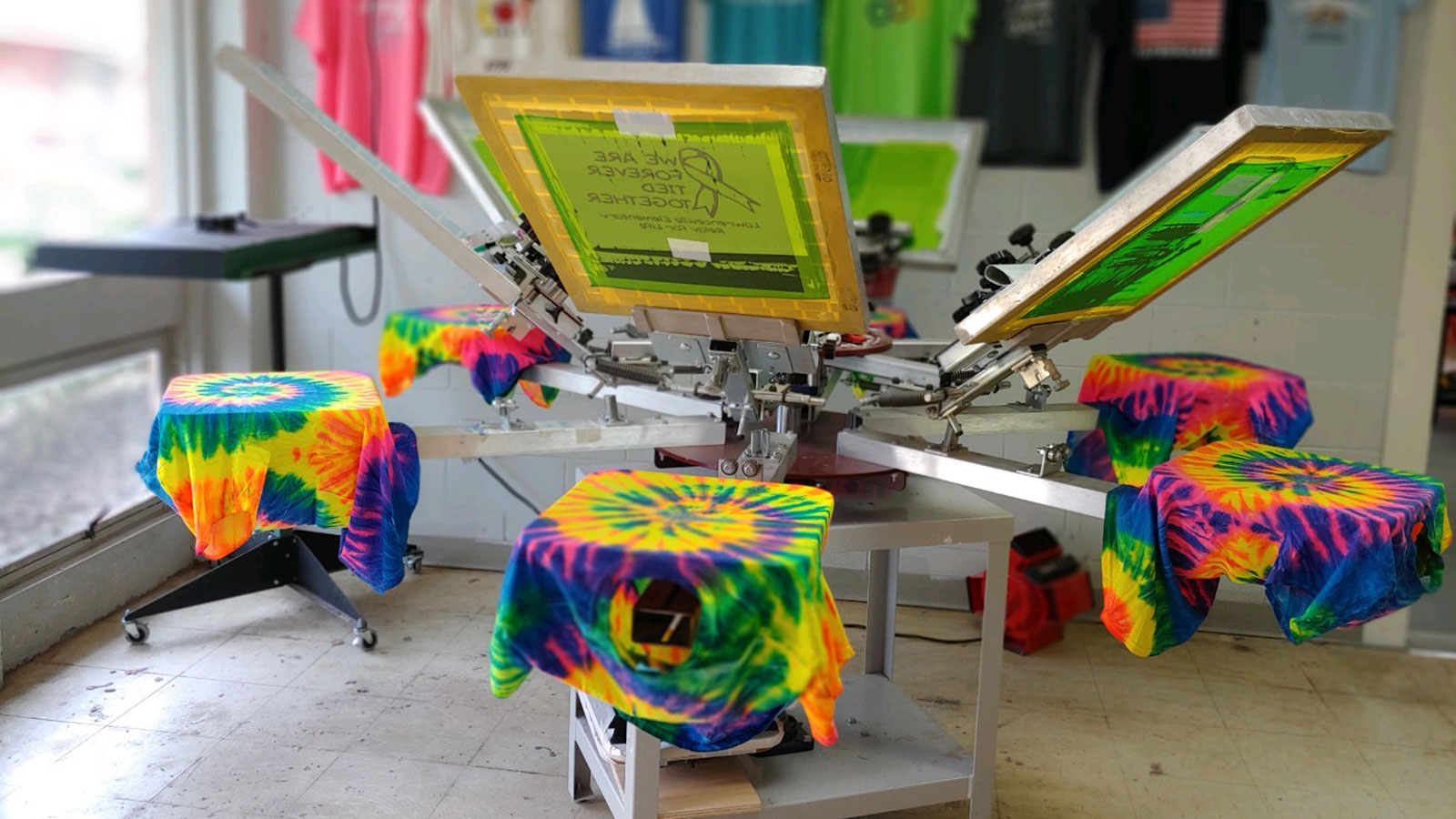Beginner-Friendly Screen Printing Kit for DIY Projects
Wiki Article
Screen Printing Uncovered: Everything You Need to Know About Tee Shirt and Garment Printing Strategies
Screen printing is an interesting method that incorporates art with method, supplying countless possibilities for imagination. Prepared to check out the vital elements that make display publishing an art form?
The Basics of Display Printing: Just How It Functions
When you dive right into display printing, you'll discover it's both a scientific research and an art. At its core, display printing entails developing a stencil, or display, that permits ink to go through just in details areas (screen printing kit). You start by picking your style and preparing your display with a light-sensitive solution. As soon as you expose this emulsion to light, it hardens, leaving your style as a negative space.Following, you'll blend your inks and prepare your printing surface. Placement the display over the fabric, after that make use of a squeegee to press ink via the screen onto the garment. This process requires accuracy, as you want clear, dynamic prints. After printing, you'll cure the ink with heat, ensuring it complies with the fabric and lasts with cleans. Each step is essential, and understanding them will certainly boost your screen printing abilities, transforming straightforward garments into unique, meaningful pieces.
Kinds Of Screen Printing Methods
As soon as you grasp the fundamentals of display printing, it's time to discover the various methods that can elevate your styles. One preferred method is traditional screen printing, where ink is pushed via a stenciled screen. This strategy is terrific for vibrant, lively colors. After that there's water-based ink printing, which uses a softer feel and is environment-friendly, yet it calls for a various approach to treating.If you're going for fine details, think about discharge printing. This method gets rid of color from the material, leaving a soft, vintage appearance. An additional alternative is plastisol printing, known for its sturdiness and brilliant shades, making it a preferred for several brand names. Lastly, explore halftone printing to create slope results and intricate designs. Each strategy has its one-of-a-kind appeal, so do not think twice to try them bent on find what matches your style best!
Important Equipment for Display Printing
To attain magnificent outcomes in display printing, having the best devices is essential. Initially, you'll require a tough display printing frame, which holds the mesh that moves your design onto the garment. Next, purchase high-quality mops; these are crucial for using ink equally throughout the display. You'll also require an excellent direct exposure system to develop your screens, along with a washout cubicle for cleansing them after usage. A reputable heat resource, like a conveyor clothes dryer or heat press, is important for healing your prints to guarantee longevity. Don't fail to remember a correct workspace, geared up with tables and storage space for your products. Ultimately, safety equipment, such as gloves and masks, will keep you risk-free from chemicals and inks. With the right tools, you'll be well on your way to producing professional-quality prints.Selecting the Right Inks and Products
When picking inks and products for display printing, you need to consider the sort of ink that functions ideal for your task. Consider fabric compatibility to ensure your layouts look last and wonderful long. Likewise, explore environmentally friendly ink choices to make your printing process much more lasting.Sorts Of Screen Inks
Selecting the best screen ink is necessary for attaining vibrant, long lasting prints that satisfy your task's requirements. There are numerous kinds of screen inks to check out. Plastisol ink is prominent for its versatility and simplicity of use, offering exceptional color opacity on dark textiles. Water-based ink, on the other hand, offers a softer feeling and is green, making it suitable for those aiming to lessen their ecological effect. Discharge inks get rid of color from the textile, causing a soft, classic look however require details handling. Specialized inks, such as glow-in-the-dark or metal, can add unique effects to your styles. Evaluate your project demands and choose the ink that lines up ideal with your wanted outcome.
Material Compatibility Considerations
Recognizing textile compatibility is crucial for achieving premium display prints, especially given that various products react distinctly to numerous inks. When choosing inks, think about the material type-- cotton, polyester, or blends. For cotton, water-based inks function well, supplying softness and breathability. Polyester, on the other hand, typically calls for plastisol inks for far better adhesion and dynamic shades. You may need to use a combination of both kinds if you're printing on blends. Constantly test your inks on example material to ensure they stick correctly and keep shade integrity. Additionally, bear in mind that textile weight and texture can affect the last outcome, so choosing the best ink and product combination is crucial for your job's success.Eco-Friendly Ink Options
Green inks are coming to be a prominent option for display printers that desire to minimize their environmental impact while preserving quality. When picking inks, consider water-based inks, which are much less unsafe and easier to clean up contrasted to conventional solvents.In addition, try to find inks made from renewable energies, such as soy or vegetable-based choices. By choosing the appropriate inks and products, you'll not only produce stunning designs but likewise add to a much more sustainable printing procedure. Make the button, and your prints will certainly reflect your dedication to the setting!
Preparing Your Layout for Display Printing

File Layout Requirements
To ensure your style looks vivid and sharp on textile, you'll require to pay close focus to submit layout needs for display printing. Make certain your design has a transparent history to avoid unwanted white sides on your prints. screen printing kit Maintain shade modes in mind; CMYK is standard for screen printing, so transform your RGB develops appropriately.Color Separation Techniques
Shade separation is a vital action in preparing your design for display printing, and mastering it can significantly enhance your print quality. You'll need to break your style right into private shades, as each shade calls for a separate display during printing. This accuracy not only ensures exact color depiction but likewise improves the printing procedure.Resolution and Size
Attaining the most effective cause screen printing begins with ensuring your style has the best resolution and dimension. Preferably, your artwork ought to go to the very least 300 DPI (dots per inch) for sharp, clear prints. Your final product might look pixelated and less than professional. if you make use of lower resolution.When it involves dimension, take into consideration the dimensions of your print area. Layout your artwork to match the last print size, preferably creating it in the actual measurements you'll be printing. By doing this, you'll avoid any kind of unforeseen scaling issues.
Always examine your style in both vector and raster layouts. Vector graphics can be scaled without losing top quality, making them ideal for display printing. Preparing properly will assure your design looks amazing on every garment!
Step-by-Step Screen Printing Process
Display printing is a dynamic process that enables you to develop vivid layouts on different surfaces. To start, you'll need a display, emulsion, and your chosen ink. Prepare your screen by cleansing it extensively. Next, apply the solution evenly and let it dry in a dark area. When completely dry, expose your screen to light with your layout positioned on it, which will certainly set the solution where the light hits, developing a pattern - screen printing kit.Pour ink onto the display and utilize a squeegee to push the ink via the stencil onto the fabric. Raise the screen carefully and allow the print completely dry. You've successfully display published your layout.
Tips for Successful Screen Printing Projects
While you're diving into your screen printing jobs, keep in mind that prep work is crucial to success. Begin by gathering all your products-- inks, garments, squeegees, and screens. A clean workspace assists stop undesirable mistakes, so clean prior to you begin.Following, confirm your artwork is high-resolution and effectively sized for your garment. Examine your display for proper direct exposure and clean it completely to prevent spots. When blending your inks, follow the maker's standards to achieve the right uniformity.
During printing, apply even stress with your squeegee for consistent results. Don't hurry; take your time to validate each print satisfies your standards. After printing, allow your garments dry totally before handling or packaging them.
Finally, constantly maintain a sample of your benefit future referral. By doing this, you can analyze your progress and boost your strategies gradually. Pleased printing!

Often Asked Concerns
The length of time Does It Take to Set up a Display Printing Task?
Establishing a display printing work commonly takes around half an hour to an hour. You'll prepare the screens, mix inks, and adjust journalism. The moment varies based on intricacy and experience, so stay organized!Can I Publish on Various Fabric Enters Utilizing the Same Method?
Yes, you can print on various textile kinds making use of the very same strategy, however you'll require to readjust your settings and inks. Some textiles soak up ink in a different way, so experimenting guarantees the finest outcomes for every material.What Prevail Errors to Avoid in Screen Printing?
When display printing, avoid common mistakes like making use of the wrong ink, overlooking proper direct exposure times, or skipping pre-press checks. Constantly evaluate your arrangement and maintain tidy screens to ensure top quality results each time.How Can I Correctly Tidy and Keep My Screen Printing Tools?
To properly clean and preserve your screen printing tools, you ought to consistently wash screens with proper solvents, inspect mops for wear, and guarantee all tools are saved dust-free and dry. Uniformity stops expensive repair work and boosts performance.Is Display Printing Environmentally Friendly Contrasted to Other Approaches?
Display printing can be a lot more eco-friendly than various other techniques, specifically if you use water-based inks and eco-conscious materials. By choosing lasting supplies and methods, you minimize waste and lessen your influence on the planet.Screen Printing Uncovered: Everything You Need to Know Concerning T-Shirt and Garment Printing Techniques
At its core, screen printing involves producing a pattern, or display, that permits ink to pass via only in certain areas. Position the screen over the material, after that make use of a squeegee to press ink with the display onto the garment. One prominent technique is typical screen printing, where ink is pushed with a stenciled display.When choosing inks and materials for display printing, you require to take right into account the kind of ink that works best for your task.
Report this wiki page